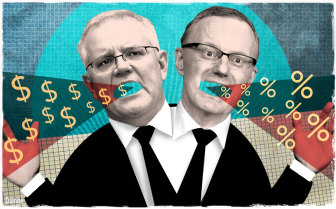Property boom as big a threat to future generations as government debt
You have to feel just a teensy bit sorry for Philip Lowe. On his own figures, announced this week, he is on course to utterly fail in the chief mission of any governor of Australia’s central bank: to keep annual inflation within a target band of 2 to 3 per cent.

From his first day on the job in September 2018, right until the end of his current term in 2023, underlying inflation is forecast to fall short of this target.
Perhaps you think that’s a good thing? Inflation eats into pay rises. It makes a dollar tomorrow worth less than a dollar today. But it’s also the way we keep things chugging along in the economy.
A healthy dose of inflation – not too hot and not too cold – is a sign our economy is operating as close to its full capacity as possible. More workers are employed, meaning they can push up the price of their labour. They can then spend their pay rises pushing up the price of a range of consumer goods and services. Price rises can add fuel to company profits which can be – although not necessarily are – recycled back to employees as pay rises.
Inflation is the spice of economic life. And the spark’s gone out.
Of course, it’s not all Phil’s fault. Far from it. COVID-19 has, of course, put a dampener on things. But even before the pandemic, Australia’s economy was struggling to light the fires of prices and wages growth.
Part of the problem is structural – and global. That’s a decline in the bargaining power of workers, brought about by international competition and new technology. But a large part – including the dearth of new business investment and the stalling in productivity growth – remains a mystery to economists.
The point is, even before COVID-19, the Reserve Bank was struggling to get inflation up to its target band, despite already very low rates. Today, Lowe seems more determined than ever to do whatever it takes to get growth going again, including signalling the cash rate will remain at 0.1 per cent until 2024 and announcing another $100 billion in government bond-buying to keep borrowing costs low.
“So the message is: interest rates are going to be low for quite a while yet,” Lowe told the National Press Club this week. “The Reserve Bank is committed to provide the support the economy needs as its recovers from the pandemic.”
But speaking on the very same stage, Prime Minister Scott Morrison struck a somewhat different chord earlier this week.
“You can’t run the Australian economy on taxpayers’ money forever,” he warned, pledging to exercise “the fiscal discipline necessary to ensure that we do not overburden future generations … We are not running a blank-cheque budget.”
In economic theory, there are two main policy levers for managing demand in the economy: “monetary policy” – that is, interest rates – and “fiscal policy” – the tax and spending decisions of government.
So far during COVID, the two levers have been operating in union – full thrust forward, with super-loose monetary policy and historic levels of government support for the economy.
But having sung from the same song sheet so far during this crisis, is Morrison about to break up the band with a premature tightening of fiscal support?
It remains to be seen. To date, Morrison and his government have delivered exemplary fiscal support for the economy. It is made all the more admirable for the gumption required to overcome deeper natural instincts – among some in government ranks, at least – for government not to step in to such an extent.
But those instincts must continue to be kept in check in 2021, and beyond, as support measures such as COVID supplements, JobKeeper and mortgage deferrals expire.
As it stands, the withdrawal of these measures will exert a contractionary impact on the economy. Households may offset some of this impact by cashing in the substantial savings buffer they have accumulated so far during the crisis. But it remains to be seen if that will be enough.
Another federal budget looms in just a little over three months. The chief task of that budget will be to ensure the planned tapering of support measures is not so steep as to leave the economy in a hole.
If Morrison does not provide enough support, the burden of policy-making will fall to the central bank. There are substantial downsides to that. Compared with fiscal policy – which can be highly nuanced, taking the form of tax cuts, welfare increases or other government spending, such as education or infrastructure – monetary policy is a blunt instrument.
All Phil can do is lower borrowing costs. Every time he does, it makes debt cheaper. And when you make debt cheaper – absent a sharp economic shock – Australians tend to go out in droves and borrow more. That pushes up house prices, making that most basic of human needs – shelter – more expensive for younger Australians to obtain.
If it’s the burden on future generations that is to be Morrison’s yardstick for future policy, it’s something to keep in mind.
Money with Jess newsletter
Practical tips and information you can trust from senior writer Jessica Irvine to help you budget, earn, invest and enjoy your money. Sign up to get it every Sunday.
Jessica Irvine is a senior economics writer with The Sydney Morning Herald.
Most Viewed in Business
Source: Thanks smh.com